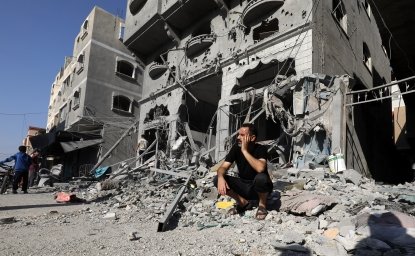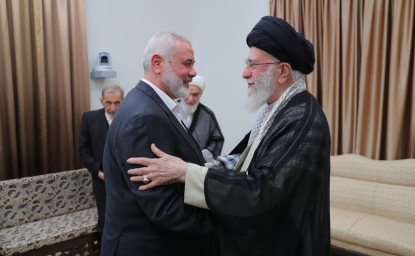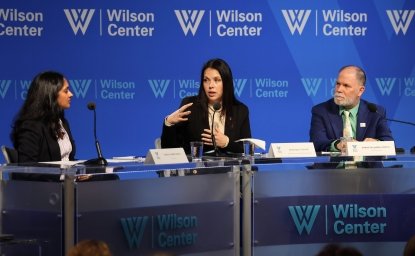On April 12, the Senate Foreign Relations Committee held a hearing on the spread of ISIS – also known as ISIL, Daesh, or the Islamic State. Expert witnesses weighed in on the threat posed by ISIS, and provided assessments of the group’s strengths and weaknesses. The following are excerpts from witness testimonies during the hearing.
Graeme Wood
Edward R. Murrow Press Fellow, Council on Foreign Relations
“I will begin with the reasonable fear. Supporters of ISIL have given me little reason to believe that their most brutal and intolerant statements are mere bravado or exaggeration for effect. It is true that they have welcomed my questions and treated me gently in person. In most cases, they seem to appreciate the comforts of the developed, peaceful countries where they live. But their conviction is real. When they talk about putting the Shia to the sword, or reinstituting slavery and other practices inconsistent with modern notions of human rights, they do so without apology, and at times with evident gusto. Their opinions are thoroughly premeditated, and they are based in an interpretation of scripture and Islamic history, as well as practical considerations. It would be folly to discount their sincerity or to interpret their beliefs as idle, ill-considered, or foolish. The fanaticism is real, and it does not reduce to other factors.”
The ISIL military is not one of the world’s most formidable, and we should not mistake the grandeur of its language for vast operational capacity.
“I come, then, to the topic of unreasonable fear. First, we should note the mismatch between the soaring ideological claims of ISIL and its practical capability. Its mode of expansion in Syria and Iraq, through fast movement of lightarmored vehicles in familiar terrain, does not readily transfer into most other places, and would certainly fail in Turkey or heavily Kurdish or Shiite areas of Iraq. It requires desperate, beleaguered local populations, with some base willingness to contemplate a harsh revivalist Islamism as an alternative to the status quo. The ideology of ISIL echoes Nazism in its genocidal ambitions and tone, but it is not matched by an equally powerful war machine. The ISIL military is not one of the world’s most formidable, and we should not mistake the grandeur of its language for vast operational capacity.
“Second, the Islamic State still prioritizes building a caliphate and protecting its diminishing core territories -- not in attacking Western targets in spectacular ways, a la September 11. I make myself hostage to fortune by advancing this claim. But it remains correct, Brussels and Paris notwithstanding.”
“None of the above points implies that ISIL will not attack the US and Europe; on the contrary, I assume they will. And the group’s changing fortunes could easily alter its calculations and compel it to invest heavily in foreign operations, at the expense of local ones. However, when they do so, they will not mobilize their differentiating strength, which is their enormous numbers. Instead, they will be revisiting an Al Qaida strategy that we have begun to learn to counter.
“Finally, although the conversion into a mass movement makes ISIL less fragile and harder to counter, it carries important dangers for ISIL as well. Mass movements resist central control, and they are vulnerable to changes of style, culture, and generational preference. ISIL has thrust itself into the consciousness of many, many Muslims, and has thereby suggested itself as an outlet for existential, political, and religious desires. It has no way of ensuring that next year’s seekers will direct their energies toward the same ends. A sophisticated policy response to ISIL’s rise will take into account not only military and political dimensions, but also countercultural, religious, and existential ones. Unfortunately, since government is typically at its most hapless when trying to deal with these types of issues, much work remains to be done -- much of it not by government but by civil society.”
Click here for the full statement
Matthew Levitt
Director, Stein Program on Counterterrorism and Intelligence, The Washington Institute for Near East Policy
“The Brussels bombings have made it plain that the scale of the threat posed by the Islamic State to the West is far larger than most Westerners had previously thought. That threat is no longer limited to the radicalization of the 5,000-6,000 European citizens who left the comfort and safety of their homes to fight alongside the Islamic State in Syria, Iraq and, more recently, Libya. Nor has it only expanded to include so-called “lone-wolf” plots — self-organized attacks carried out by homegrown radicals. The Brussels bombings have made it painfully clear that the Islamic State is determined to plan and direct attacks in the West that are far more sophisticated and lethal than such small-scale mayhem.
“It would be understandable if the public expressed anxiety and dismay about this metastasized danger. But the West’s counterterrorism officials are not entitled to feel surprise. For anyone paying close enough attention, the Islamic State’s expanded capabilities have been evident for well over a year.”
“The harsh fact is that communities ripe for radicalization exist across Europe—including in the heart of the capital of the European Union—and no one quite knows what to do about it. The day of my visit to Molenbeek I first rode a few quick stops on the Brussels metro from my hotel in the EU district to Molenbeek, where I met the mayor at her office together with police chiefs, members of the local police department’s “counter-radicalization cell” and civilian “prevention officers” who had just concluded their weekly status-check on the local government’s counterradicalization, and social integration efforts. Their goal seems Sisyphean: reintegrating returning foreign terrorist fighters back into society and preventing still more disenfranchised Muslim youth from looking to the Islamic State for purpose and belonging.”
“The harsh fact is that communities ripe for radicalization exist across Europe—including in the heart of the capital of the European Union—and no one quite knows what to do about it.
“Recruiters offer a sense of family to people from broken homes; of belonging to people who feel disenfranchised from society; of empowerment to people who feel discriminated against; and of a higher calling and purpose to people who feel adrift. Recruiters pitch small groups of friends and family together: “You don’t really belong here. You are not wanted here. You can’t live here. You can’t get a job here.” Only then comes the religious extremist part: “Clearly, you should not be living among the infidels.” What Islamic State offers them, in a nutshell, is a fast track from zero to hero.”
“And while there is a component of religious extremism, Belgian officials stress, it is only skin deep. The suspects appear to be mainly criminals who are attracted to something that gives them identity and a sense of empowerment. They are radicalized to the idea of the Islamic state far more than to Islam. “Salafism [a radical Islamist ideology] is mainstream in Belgium,” was a refrain I heard from several of the officials I met. “Not all Salafists are terrorists,” they stressed, “but all our terrorists were targeted for recruitment by Salafists in these neighborhood extremist networks.”
Click here for the full statement
Matthew Olsen
Former Director, National Counterterrorism Center
“By any measure, ISIS presents the most urgent threat to our security in the world today. The group has exploited the conflict in Syria and sectarian tensions in Iraq to entrench itself in both countries, now spanning the geographic center of the Middle East. Using both terrorist and insurgent tactics, the group has seized and is governing territory, while at the same time securing the allegiance of allied terrorist groups across the Middle East and North Africa. ISIS’s sanctuary enables it to recruit, train, and execute external attacks, as we have now seen in Europe, and to incite assailants around the world. It has recruited thousands of militants to join its fight in the region and uses its propaganda campaign to radicalize countless others in the West. And at the same time, we continue to face an enduring threat from al Qaida and its affiliates, who maintain the intent and capacity to carry out attacks in the West.”
“Three overarching factors account for the rise and rapid success of ISIS over the past three years.
“First, ISIS has exploited the civil war in Syria and the lack of security in northern Iraq to establish a safe haven. At the same time, Assad’s brutal suppression of the Syrian people acted as a magnet for extremists and foreign fighters. In western Iraq, the withdrawal of security forces during the initial military engagements with ISIS left swaths of territory ungoverned. ISIS has used these areas to establish sanctuaries in Syria and Iraq from where the group could amass and coordinate fighters and resources with little interference. With virtually no security forces along the Iraq-Syria border, ISIS was able to move personnel and supplies with ease within its held territories.
We should not underestimate the capacity of ISIS and other groups to adapt and evade our defenses and to carry out acts of violence, both here at home and around the world. But no terrorist group is invincible.
“Second, ISIS has proven to be an effective fighting force. Its battlefield strategy employs a mix of terrorist operations, hit-and-run tactics, and paramilitary assaults to enable the group’s rapid gains. These battlefield advances, in turn, sparked other Sunni insurgents into action, and they have helped the group hold and administer territory. Disaffected Sunnis have had few alternatives in Iraq or Syria. The leadership in both countries has pushed them to the sidelines in the political process for years, failing to address their grievances. ISIS has been recruiting these young Sunnis to fight. Since September 2014, the U.S.-led military coalition has halted ISIS’s momentum and reversed the group’s territorial gains, but ISIS has sought to adapt its tactics in the face of coalition air strikes.
“Third, ISIS views itself as the new leader of the global jihad. The group has developed an unprecedented ability to communicate with its followers worldwide. It operates the most sophisticated propaganda machine of any terrorist group. ISIS disseminates timely, high-quality media content on multiple platforms, including on social media, designed to secure a widespread following for the group. ISIS uses a range of media to tout its military capabilities, executions of captured soldiers, and battlefield victories.”
“In the wake of the terrorist attacks in Europe and here in the United States, our continued focus on ISIS and transnational terrorist threats is absolutely warranted. We should not underestimate the capacity of ISIS and other groups to adapt and evade our defenses and to carry out acts of violence, both here at home and around the world. But no terrorist group is invincible. The enduring lessons of 9/11 are that we can overcome and defeat the threat of terrorism through strength, unity, and adherence to our founding values, and that American leadership is indispensible to this fight.”
Click here for the full statement

The Islamists
Learn more about Hamas and how it relates to similarly aligned organizations throughout the region. Read more

Explore More
Browse Insights & Analysis
Israel Escalates Attacks in Gaza: What’s Next?

Israel Expands Operations on Multiple Fronts: Perspectives on the Conflict

